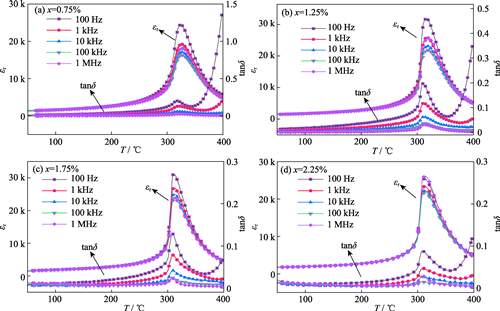

BiAlO3掺杂PZT陶瓷的高压电性能和低电场应变滞后
收稿日期: 2022-03-22
修回日期: 2022-07-06
网络出版日期: 2022-08-26
High Piezoelectric Property and Low Electric Field-strain Hysteresis of BiAlO3-doped PZT Ceramics
Received date: 2022-03-22
Revised date: 2022-07-06
Online published: 2022-08-26
Supported by
National Natural Science Foundation of China(51831010);National Key R&D Program(2021YFA0716502);National Key R&D Program(2021YFB3800604)
铅基压电陶瓷因其优异的压电性能, 被广泛应用于压电器件。其中, 压电驱动器要求压电陶瓷具有较高压电性能并且在电场下具有较高的电致应变和较小的应变滞后。本研究通过施主-受主共掺, 得到高压电性能和低电场应变滞后的PZT陶瓷。采用传统固相反应法制备了(1-x)(Pb0.95Sr0.05)(Zr53Ti47)O3-xBiAlO3+0.2%MnO2陶瓷(掺杂量为质量百分数), 并对其微观结构和压电性能进行了研究。结果表明:BiAlO3掺杂量较少时, 陶瓷中缺陷偶极子的“钉扎”效应使得陶瓷畴壁转动困难, 陶瓷压电性能较弱, 应变滞后也较小。随BiAlO3掺杂量增加, 缺陷偶极子“钉扎”效应减弱, 陶瓷的压电性能和应变滞后随之提高。本实验得到的性能最优组分为x=1.75%, 该组份陶瓷的压电系数d33=504 pC/N, 机电耦合系数kp=0.71, 机械品质因数Qm=281, 居里温度TC=312 ℃, 在10 kV/cm电场下的应变滞后仅为15%, 并且还具有较好的温度稳定性, 是一种具有应用价值的压电驱动器用压电陶瓷材料。

刘鼎伟 , 曾江涛 , 郑嘹赢 , 满振勇 , 阮学政 , 时雪 , 李国荣 . BiAlO3掺杂PZT陶瓷的高压电性能和低电场应变滞后[J]. 无机材料学报, 2022 , 37(12) : 1365 -1370 . DOI: 10.15541/jim20220162
Lead-based piezoelectric ceramics are widely used in piezoelectric devices due to their excellent piezoelectric properties. Piezoelectric actuators require piezoelectric ceramics with high piezoelectric properties and high precision displacement as well as small strain hysteresis under applied electric fields, which can be obtained by donor-acceptor co-doping. In this work, (1-x)(Pb0.95Sr0.05)(Zr53Ti47)O3-xBiAlO3 + 0.2%MnO2 ceramics were prepared by a traditional solid-state reaction method (doping amount in mass percentage). The microstructure and piezoelectric properties of the prepared ceramics were investigated. The results demonstrated that the defect dipole can hinder the domain rotation in a few additions of BiAlO3, resulting in a relatively low piezoelectric property and low strain hysteresis under electric fields. With more BiAlO3 addition, the piezoelectric properties and strain hysteresis of the ceramics are improved because the pinning effect to the domain rotation become weak. The optimal performance is obtained at x=1.75%, where the piezoelectric coefficient (d33), electromechanical coupling coefficient (kp), mechanical quality factor (Qm) and Curie temperature (TC) are 504 pC/N, 0.71, 281 and 312 ℃, respectively. This piezoelectric ceramic show a relative high strain and low strain hysteresis (only 15%) under the electric field of 10 kV/cm. Due to the high piezoelectric performance and low electric field strain hysteresis along with the good temperature stability, the (1-x)(Pb0.95Sr0.05)(Zr53Ti47)O3-xBiAlO3 + 0.2%MnO2 ceramics can be a kind of piezoelectric ceramic with practical application potentials for the piezoelectric actuators.

| [1] | CROSS L E. Ferroelectric materials for electromechanical transducer applications. Materials Chemistry and Physics, 1996, 43: 108-115. |
| [2] | CHAN H I W. Smart Ferroelectric materials for sensors and mechatronic device applications. Proceedings 1999 IEEE Hong Kong Electron Devices Meeting (HKEDM 99). Hong Kong, 1999: 68-71. |
| [3] | KHOLKIN A L, BDIKIN I K, KISELEV D A, et al. Nanoscale characterization of polycrystalline ferroelectric materials for piezoelectric applications. Journal of Electroceramics, 2007, 19: 83-96. |
| [4] | PARK S E, SHROUT T R. Ultrahigh strain and piezoelectric behavior in relaxor based ferroelectric single crystals. Journal of Applied Physics, 1997, 82: 1804-1811. |
| [5] | DONG C, LIANG R H, ZHOU Z Y, et al. Piezoelectric property of PZT-based relaxor-ferroelectric ceramics enhanced by Sm doping. Journal of Inorganic Materials, 2021, 36: 1270-1276. |
| [6] | LIU X, XUE S D, MA J P, et al. Electric-field-induced local distortion and large electrostrictive effects in lead-free NBT-based relaxor ferroelectrics. Journal of the European Ceramic Society, 2018, 38: 4631-4639. |
| [7] | PENG J G L, ZENG J T, LI G R, et al. Softening-hardening transition of electrical properties for Fe3+-doped (Pb0.94Sr0.05La0.01)- (Zr0.53Ti0.47)O3 piezoelectric ceramics. Ceramics International, 2017, 43: 13233-13239. |
| [8] | YAN Y X, LI Z M, XIA Y S, et al. Ultra-high piezoelectric and dielectric properties of low-temperature-sintered lead hafnium titanate-lead niobium nickelate ceramics. Ceramics International, 2020, 46: 5448-5453. |
| [9] | FENG Y, LI W L, XU D, et al. Enhanced piezoelectric properties and constricted hysteresis behaviour in PZT ceramics induced by Li+-Al3+ ionic pairs. RSC Advances, 2016, 6: 36118-36124. |
| [10] | THONGMEE N, WATCHARAPASORN A, JIANSIRISOMBOONS. Structure-property relations of ferroelectric Pb(Zr0.52Ti0.48)O3-(Bi3.25La0.75)Ti3O12 ceramics. Current Applied Physics, 2008, 8: 367-371. |
| [11] | KIM Y M, KIM J C, UR S C, et al. Effects of Al2O3 on the piezoelectric properties of Pb(Mn1/3Nb2/3)O3-PbZrO3-PbTiO3 ceramics. Journal of Electroceramics, 2006, 16: 347-350. |
| [12] | LEE S M, LEE S H, YOON C B, et al. Low-temperature sintering of MnO2-doped PZT-PZN piezoelectric ceramics. Journal of Electroceramics, 2007, 18: 311-315. |
| [13] | KOZIELSKI L, ADAMCZYK M, ERHART J, et al. Application testing of Sr doping effect of PZT ceramics on the piezoelectric transformer gain and efficiency proposed for MEMS actuators driving. Journal of Electroceramics, 2012, 29: 133-138. |
| [14] | PANDEY D, SINGH A K, BAIK S. Stability of ferroic phases in the highly piezoelectric Pb(ZrxTi1-x)O3 ceramics. Acta Crystallographica A-Foundation and Advances, 2008, 64: 192-203. |
| [15] | KIM H T, NAM M H, KIM J H, et al. Microwave dielectric properties and chemical resistance of low-temperature-sintered CaZrB2O6 ceramics. International Journal of Applied Ceramic Technology, 2009, 6: 587-592. |
| [16] | KUZENKO D V. Critical temperature below the Curie temperature of ferroelectric ceramics PZT. Journal of Advanced Dielectrics, 2021, 11: 2150006. |
| [17] | PEREIRA M, PEIXOTO A G, GOMES M J M. Effect of Nb doping on the microstructural and electrical properties of the PZT ceramics. Journal of the European Ceramic Society, 2001, 21: 1353-1356. |
| [18] | SHUKLA A K, AGRAWAL V K, DAS I M L, et al. Dielectric response of PLZT ceramics x/57/43 across ferroelectric-paraelectric phase transition. Bull. Mat. Sci., 2011, 34: 133-142. |
| [19] | KAMEL T M, DE WITH G. Poling of hard ferroelectric PZT ceramics. Journal of the European Ceramic Society, 2008, 28: 1827-1838. |
| [20] | REN X B. Large electric-field-induced strain in ferroelectric crystals by point-defect-mediated reversible domain switching. Nature Materials, 2004, 3: 91-94. |
| [21] | LI F, ZHANG S J, LI Z R, et al. Recent development on relaxor-PbTiO3 single crystals: the origin of high piezoelectric response. Progress in Physics, 2012, 32: 178-198. |
/
| 〈 |
|
〉 |